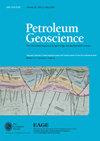坦桑尼亚沿海曼达瓦盆地的石油地球化学方面:今天作为部分生物降解沥青发生的迁移石油的起源
IF 2.1
4区 地球科学
Q3 GEOSCIENCES, MULTIDISCIPLINARY
引用次数: 5
摘要
坦桑尼亚沿海Mandawa盆地的上侏罗统-下白垩统浅海沉积序列距离坦桑尼亚2号区块的海上天然气发现约80公里。在本文中,我们提供了石油地球化学数据,包括从露头样品中提取的沥青,这些数据与了解陆上“石油系统”有关,也可能与海上盆地有关。尽管所有露头样品都存在一些生物降解和风化现象,但分析的大多数沥青样品都含有成熟的运移油。地质标志物成熟度跨度(c13 ~ c15范围)覆盖了整个油凝析/湿气窗(Rc = 0.7 ~ 2% Rc,其中Rc为镜质组反射率计算值),生物标志物一般为油窗(Rc = 0.7 ~ 1.3% Rc)。这表明沥青提取物代表了运移油和凝析油的几个阶段,这表明这些样品是一个活跃的或最近活跃的运移体系或“石油系统”的一部分。推断沥青烃源岩相为ⅱ/ⅲ型干酪根,为硅屑—碳酸盐相。这是一个亲油干酪根,典型的海相沉积体系,近源陆源物质流入,与原位海洋藻类有机质(OM)混合。C28/ c29甾烷、扩展三环萜烷比(ETR)、北二胆固醇甾烷和芳香甾烷等年龄特异性生物标志物的应用表明,不止一种烃源岩对沥青有贡献。可能的年龄仅限于中生代(即不包括晚古生代),最有可能的烃源岩属于早侏罗世。应该进行更多的地球化学和地质研究,以进一步发展对曼达瓦盆地石油系统的一般了解及其对海上和陆上“石油系统”的影响。本文还介绍了对已公布的Pande、Temane和Inhassoro气田(莫桑比克)的天然气成分和同位素数据的重新解释,这对天然气占主导地位的地区可能发现石油具有指导意义。本文章由计算机程序翻译,如有差异,请以英文原文为准。
Petroleum geochemical aspects of the Mandawa Basin, coastal Tanzania: the origin of migrated oil occurring today as partly biodegraded bitumen
The shallow-marine Upper Jurassic–Lower Cretaceous sedimentary successions of the Mandawa Basin, coastal Tanzania, are located about 80 km away from the offshore gas discoveries of Block 2, Tanzania. In this paper we present petroleum geochemical data, including bitumen extracted from outcrop samples which are relevant to the understanding of the onshore ‘Petroleum System’ and possibly also to the offshore basin. Despite some biodegradation and weathering, common to all outcrop samples, most bitumen samples analysed contain mature migrated oil. The maturity span of geomarkers (C13–C15 range) covers the entire oil and condensate/wet gas window (Rc = 0.7–2% Rc, where Rc is the calculated vitrinite reflectance), with the biomarkers generally indicating the oil window (Rc = 0.7–1.3% Rc). This suggests that the bitumen extracts represent several phases of migrated oil and condensate, which shows that the samples are part of an active or recently active migration regime or ‘Petroleum System’. The source-rock facies inferred for the bitumen is Type II/III kerogen of siliciclastic to carbonate facies. This is oil-prone kerogen, typical for a marine depositional system with an influx of proximal-derived terrigenous material blended in with in situ marine algal organic matter (OM). Application of age-specific biomarkers such as the C28/C29-steranes, extended tricyclic terpane ratio (ETR), nordiacholestanes and the aromatic steroids suggest that more than one source rock have contributed to the bitumen. Possible ages are limited to the Mesozoic (i.e. excluding the Late Paleozoic), with the most likely source rock belonging to the Early Jurassic. More geochemical and geological studies should be undertaken to further develop the general understanding of the petroleum system of the Mandawa Basin and its implications to the ‘Petroleum Systems’ both offshore and onshore. This paper also presents a reinterpretation of published gas composition and isotope data on the Pande, Temane and Inhassoro gas fields (Mozambique) with implications for possible oil discoveries in the gas-dominated region.
求助全文
通过发布文献求助,成功后即可免费获取论文全文。
去求助
来源期刊

Petroleum Geoscience
地学-地球科学综合
CiteScore
4.80
自引率
11.80%
发文量
28
审稿时长
>12 weeks
期刊介绍:
Petroleum Geoscience is the international journal of geoenergy and applied earth science, and is co-owned by the Geological Society of London and the European Association of Geoscientists and Engineers (EAGE).
Petroleum Geoscience transcends disciplinary boundaries and publishes a balanced mix of articles covering exploration, exploitation, appraisal, development and enhancement of sub-surface hydrocarbon resources and carbon repositories. The integration of disciplines in an applied context, whether for fluid production, carbon storage or related geoenergy applications, is a particular strength of the journal. Articles on enhancing exploration efficiency, lowering technological and environmental risk, and improving hydrocarbon recovery communicate the latest developments in sub-surface geoscience to a wide readership.
Petroleum Geoscience provides a multidisciplinary forum for those engaged in the science and technology of the rock-related sub-surface disciplines. The journal reaches some 8000 individual subscribers, and a further 1100 institutional subscriptions provide global access to readers including geologists, geophysicists, petroleum and reservoir engineers, petrophysicists and geochemists in both academia and industry. The journal aims to share knowledge of reservoir geoscience and to reflect the international nature of its development.
 求助内容:
求助内容: 应助结果提醒方式:
应助结果提醒方式:


